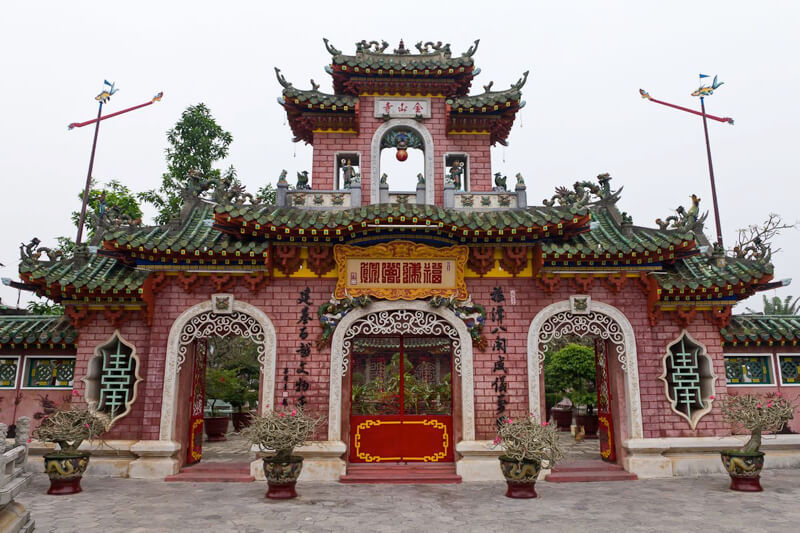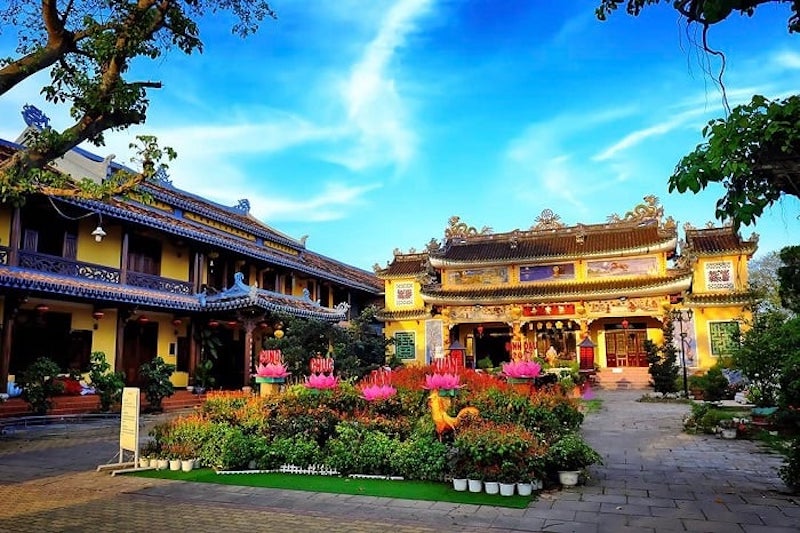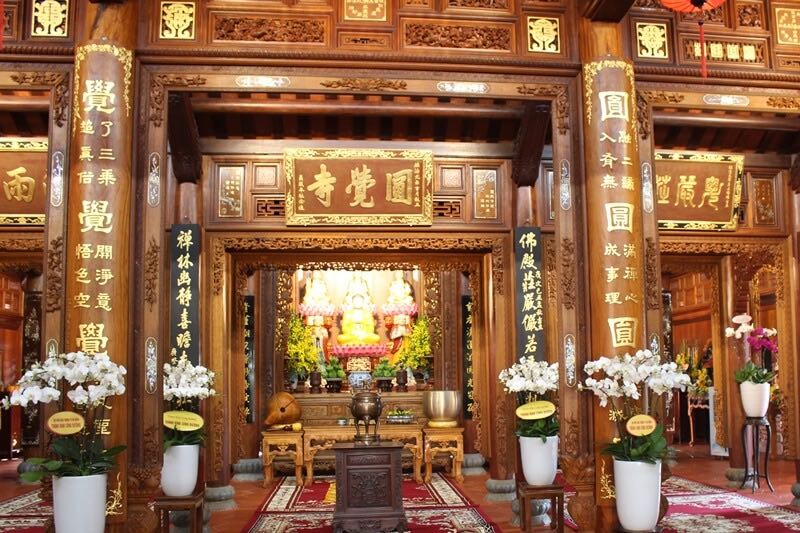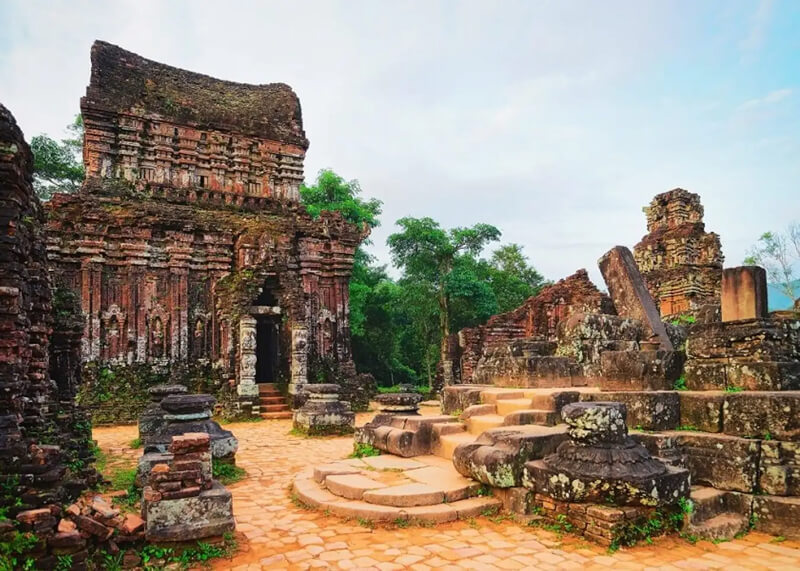
Explore ancient temples full of timeless charm during your travel to Hoi An
Despite the passage of time, Hoi An's temples have preserved their beauty and solemnity, becoming a major attraction for tourists and locals alike. These temples are not only spiritual sanctuaries but also historical and cultural landmarks of Quang Nam province. Join us as we explore the ancient temples brimming with timeless charm in the old town, and gather Hoi An traveling tips for visiting these sacred sites, perfect for your next trip.
1. Ancient temples full of timeless charm in Hoi An
1.1 Ba Mu Temple gate (Quang Nam)
Address: 675 Hai Ba Trung Street, Tam Quan, Hoi An
Ba Mu Temple has long been an unmissable stop for travelers, especially the youth. From the very first step, visitors are drawn in by the majestic gate, which showcases a unique blend of traditional Asian architecture. But what makes Bà Mụ Temple in Hoi An truly special is the perfect harmony between its refined design and the serene beauty of nature.
As you pass through the gate, a large, clear pond mirrors the sky above, creating a picturesque and peaceful scene. Surrounding the temple are lush green trees, whose rustling leaves and birdsong blend with the sound of temple bells, offering visitors a tranquil escape from their worries.
More than just a spiritual destination, Bà Mụ Temple has also become a "photo heaven" for the younger generation. The vintage scenery around the pond and the gate, steeped in history, provides the perfect backdrop for photos. Whether you’re here to admire the architecture or simply take in the atmosphere, this temple is a must-visit when you travel to Hoi An.
>> See more: When was the Ancient Town of Hoi An recognized as a World Cultural Heritage site?

When traveling to Hoi An, be sure to visit Bà Mụ Temple Gate (Quang Nam).
1.2 Phuc Kien Temple (Hoi An)
Address: 46 Tran Phu, Cam Chau, Hoi An
Standing out in the heart of Hoi An’s ancient town, Phuc Kien Temple, also known as the Phuc Kien Assembly Hall, has long been a cultural and spiritual symbol. Recognized as a National Historical and Cultural Monument in 1990, the temple not only attracts visitors but also plays a crucial role in the spiritual life of locals.
With its traditional architectural style, Phuc Kien Temple welcomes travelers with its grand Tam Quan gate and curved, yin-yang roof tiles. The vibrant red tones and intricately carved designs make the temple a standout amidst the surrounding old houses. The unique architecture reflects the finesse of the craftsmen while symbolizing luck and prosperity.
Beyond its spiritual significance, Phuc Kien Temple serves as a cultural hub for the local Chinese community. This is where religious activities, traditional festivals, and cultural events take place, helping to preserve and promote the unique cultural heritage of Quang Nam.
Travelers who visit Phuc Kien Temple not only marvel at the stunning architecture but also have the opportunity to learn about the history, culture, and spiritual life of the local people. The cultural and architectural values found here connect visitors with Hoi An's past, present, and future. As you travel to Hoi An, don't miss the chance to explore this cultural treasure.

Phuc Kien Temple
1.3 An Lac Temple (Hoi An)
Address: Nguyen Du Street, Thanh Ha, Hoi An, Quang Nam
Situated peacefully on the banks of the Thu Bon River, about 4km from the ancient town of Hoi An, An Lac Temple invites travelers with its tranquil beauty. Built in 1966, the temple initially served as a small shelter for orphans. Over time, it has been renovated and expanded, becoming one of the most famous temples in Hoi An, attracting a large number of tourists and Buddhists annually.

An Lac Temple in Hoi An
>> See more: When is the best season to visit Hoi An?
1.4 Phap Bao Temple (Hoi An)
Address: 7 Hai Ba Trung Street, Tam Quan, Hoi An
Famous for its expansive grounds and lush green surroundings, Phap Bao Temple attracts visitors from all over who seek tranquility and inner peace.
As the largest temple in Hoi An, Phap Bao Temple offers a spacious and serene environment. The temple's design emphasizes harmony with nature, with tall trees and fresh air enveloping the grounds. Walking through the temple's courtyard, visitors feel as though they've left behind all their worries, blending into nature and discovering peace in their hearts.
More than just a spiritual destination, Phap Bao Temple is a must-see for those who travel to Hoi An. Visitors can explore the unique architecture, learn about the history of Buddhism in the region, and take part in traditional Buddhist activities and festivals frequently held here.
With its convenient location, peaceful atmosphere, and rich cultural value, Phap Bao Temple is a destination that should not be missed when you travel to Hoi An. Come here to experience the tranquility, marvel at the architecture, and discover the unique Buddhist culture of this ancient town.

Pháp Bảo Temple
1.5 Hai Tang Temple (Hoi An)
Located on the beautiful Cham Island, Hải Tạng Temple attracts visitors from near and far to admire its ancient architecture and seek spiritual tranquility.
The name "Hải Tạng" carries deep meaning, reflecting the harmonious combination of two elements: "Hải" (sea) and "Tạng" (the vast teachings of Buddha). The temple serves as a “treasure trove” of Buddhist knowledge, where visitors come to cleanse their souls and aspire toward higher spiritual values.
When you travel to Hoi An, Hải Tạng Temple is an ideal destination for finding peace and balance. The pristine beauty of the temple, set against the backdrop of the ocean, offers a soothing escape from everyday life.
1.6 Vien Giac Temple (Hoi An)
Address: 34 Hung Vuong Street, Hoi An
Viên Giác Temple captivates visitors with its ancient and sacred beauty. Built in 1841, it has withstood the test of time, retaining its cultural and architectural value. It is a spiritual haven for those traveling to Hoi An.
Upon entering the main hall, visitors are immediately enveloped in a sense of peace and reverence. At the center stands a majestic statue of Buddha Shakyamuni in deep meditation, offering comfort and tranquility to all who enter. The temple’s architecture, featuring intricate carvings and gracefully curved roofs, exemplifies the essence of Vietnamese Buddhist culture.
The quiet atmosphere of the temple, along with the gentle chime of the bells, brings visitors to a serene world far removed from the hustle and bustle of daily life.
>>See more: What is unique about Hoi An Ancient Town's architecture?

Vien Giac Temple
1.7 My Son Sanctuary
Address: Duy Phú, Duy Xuyen, Quang Nam
Nestled amidst the majestic mountains of Quang Nam, the My Son Sanctuary stands out with its magnificent and mysterious beauty, representing the ancient Cham Pa culture. This is the largest Cham Pa relic complex in Vietnam, consisting of over 70 temples and towers with unique and intricate architecture, recognized by UNESCO as a World Cultural Heritage site.
The most striking feature of My Son Sanctuary is its Cham towers, constructed meticulously by stacking baked bricks together with remarkable precision. Each tower boasts its own distinct beauty, adorned with intricate decorative patterns and vivid sculptures depicting deities, rituals, and the daily life of the ancient Cham people. Among the highlights are the statues of Shiva, the supreme deity in Hinduism, and the Cham dancers, gracefully depicted with soft, flowing lines, exuding elegance and allure. The intricate motifs reflect the Cham Pa people's beliefs and their perceptions of the natural and spiritual world.
In addition to its architectural marvels, My Son Sanctuary also captivates visitors with its pristine and majestic natural surroundings. Enveloped by towering mountain ranges, the site creates a picturesque and mystical landscape. The gentle sound of flowing streams, the chirping of birds, and the fresh, cool air transport visitors to another world, far from the hustle and bustle of everyday life. Be sure to update your travel to Hoi An tips when visiting My Son Sanctuary to ensure a smooth and enriching journey.

Mỹ Sơn Sanctuary
2. Experience Travel to Hoi An When Visiting Pagodas
One important aspect travelers should keep in mind is gaining experience during their travel to Hoi An when visiting the many pagodas in this ancient town. Visitors need to follow a few rules to show respect for local customs and the sacredness of these religious spaces:
Dress modestly
- It’s advisable to dress appropriately, covering the body respectfully. Avoid wearing overly revealing tops, shorts, or short skirts when visiting the pagodas.
- Choose clothing suitable for a spiritual environment, reflecting elegance and respect for local culture.
Maintain silence
- Keep quiet and avoid speaking loudly, making noise, or laughing within the pagoda grounds.
- Move gently and walk softly to avoid disturbing others and to maintain the tranquility of the sacred space.
Respect the artifacts
- Do not touch the sacred objects, Buddha statues, or altar items without permission.
- Keep the environment clean, avoid littering, and ensure you don't damage any part of the pagoda.
Worship guidelines
- If you wish to participate in worship, prepare simple offerings that align with the temple’s practices.
- Avoid offering meat, meaning don’t bring food, drinks, or inappropriate items into the sacred space.
Respect local culture
- Learn about the local culture and traditions of the people in Hoi An before visiting a pagoda.
- Be polite and friendly to the monks and fellow visitors.
Following these rules reflects travelers' respect for the culture, history, and beliefs of the people of Hoi An. It also helps protect the cultural heritage and ensures a serene, spiritual environment for everyone.
>> See more: 40+ places to visit in Hoi An that captivates travelers
Exploring the ancient pagodas in Hoi An is not only a spiritual experience but also an opportunity to learn about the culture and history of this unique Quang Nam province. Each pagoda stands as a testament to the enduring presence of Buddhism and the country's treasured values. Embark on your travel to Hoi An to discover these historic pagodas, and you’ll find deep cultural and spiritual meaning in the intricately carved roofs, majestic Buddha statues, and delicate patterns that adorn each structure. Remember to keep these tips in mind during your visit for a smoother and more fulfilling trip.
-
Hotline: 1900 63 66 00
-
Press 1 For tickets
-
Press 2 For Customer Service
Latest news
![Over 30 Unique Things To Do In Hoi An Viet Nam [Monthly Update]](public/media/thumb/dao-ky-uc-hoi-an-la-mot-quan-the-du-lich-nghi-duong-van-hoa-nam-ngay-canh-pho-co1-90x90.jpg)
Over 30 Unique Things To Do In Hoi An Viet Nam [Monthly Update]

Where to Stay in Hoi An? Essential Tips for Choosing the Ideal Accommodation for First-Timers

Discover the Chinese Assembly Halls in Hoi An: Cultural Icons of the Ancient Town

Hoi An Specialties by Season: What to Eat Throughout the Year











![Over 30 Unique Things To Do In Hoi An Viet Nam [Monthly Update]](public/media/thumb/dao-ky-uc-hoi-an-la-mot-quan-the-du-lich-nghi-duong-van-hoa-nam-ngay-canh-pho-co1-358x223.jpg)


Comment